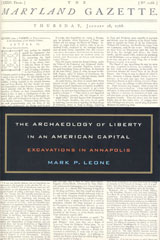Book Review
The Archaeology of Liberty in an American Capital: Excavations in Annapolis
By Mark P. Leone. Berkeley: University of California Press, 2005; 327 pp., illustrations, photographs, tables, appendix, bibliography, index; cloth $39.95.
 |
Mark Leone's latest book is based on his Public Archaeology in Annapolis program that began in 1982. Through the program, Leone has trained many undergraduate and graduate students in historical archeology, and he has opened up the worlds of archeology and interpretation to a generation of Annapolis residents and visitors. The project has always included public outreach and educational components. Over the years, it has reached beyond established preservation and historical communities into marginalized and disadvantaged communities in Annapolis.
The Archaeology of Liberty in an American Capital is not, however, a summary of 25 years of public archeology in Annapolis. Very little, in fact, is devoted to descriptive analyses of archeological features and material remains. Instead, the book uses specific examples from Annapolis to explain the virtues and fallacies of mid-20th-century economic theories of capitalism (particularly possessive individualism). The book also chronicles Leone's own intellectual journey from Marxist philosophy, through structuralism and materialism, to possessive individualism and beyond.(1)
Leone focuses on a range of examples of 18th-century material culture in Annapolis. Specifically, he examines colonial gardens, the city plan, the print shop and type from the Maryland Gazette newspaper, standardized tableware, and the spirit bundles found at several houses. He relates how the plane geometry of the colonial gardens of Annapolis's elite and the city plan, for instance, reinforced 18th-century social hierarchies and other power relations. Drawing on the writings on panopticism of the 20th-century French philosopher Michel Foucault, he relates how architectural design had a hand in normalizing societal behavior by creating an environment of mutual observation and surveillance that kept individual freedoms (expression, behavior, and so on) in check.(2)
Turning to type and tableware, he suggests that their standardization had similar controlling influences on individuals. The former established a uniformity of expression and gave people a false sense that they had an equal voice in the new American colonies. The latter organized personal space according to societal norms and served to condition individual behavior in accordance with those norms.
According to Leone, even the West African spirit bundles contributed to this phenomenon by acculturating people of African origin to the cosmology of their African culture. Leone is not able to connect these bundles to a single African tradition but suggests that they are blending of several traditions developed in America. The content of the bundles vary from crystals and mirrors to pins, cloth, coins, and beads. The bundles are buried within the structure in a way that reflects this blended African cosmology. The bundles represented not only their connection to the spirit world but also how they ought to organize the world in which they lived. It is interesting to read, using Leone's description of material culture, how enslaved West Africans embraced this cosmology and strived for the norms and values of the new American society.
Leone presents the data well in all cases, but in his efforts to refute possessive individualism, he has overlooked the value of his examples as lessons in enculturation. Enculturation is the way that a culture teaches participants the accepted norms and values of its society. In the case of Annapolis, material culture helped enslaved Africans, free blacks, and western European immigrants understand what it meant to be an Annapolitan in the 18th century. The process of enculturation, furthermore, occurs in all societies, not just capitalist societies. The information collected from Annapolis ultimately demonstrates how material culture and the landscape evolved as the new American citizen emerged from a British colonial past.
While it tends to be pessimistic about the role of capitalism in democracy, the book forces the reader to think more deeply about exactly what the excavations reveal about human society in Annapolis during the colonial and early American periods.
At first glance, the book may seem of little use to cultural resource managers because of its heavy emphasis on Leone's philosophical exploration of Marxist and post-Marxist ideologies. However, Leone does ponder the question of how archeology may be relevant to the general public and whether archeology has anything useful to say. In his view, cultural resource managers must move beyond description and preservation of material culture and explore what material culture reveals about human relationships and the different ways in which humans organize those relationships.
This reviewer may not agree with all of Leone's conclusions, but archeology can use more books like Leone's that go beyond description and challenge the reader to find relevance and meaning in the archeological record.
Susan Snow
San Antonio Missions National Historical Park
Notes
1. Daniel Storms, "Possessive Individualism and the Domestic Roots of International Political Theory," paper presented at the Annual Meeting of the Canadian Political Science Association, Winnipeg, Manitoba, June 2-6 2004. Canadian political scientist C.B. MacPherson's mid-20th-century theory of possessive individualism built upon the earlier ideas of ownership of property espoused by the 17th-century English philosopher John Locke. McPherson's theory links human development, attainment, and identity with private ownership of possessions and of one's self, one's own capacities, and the fruits of one's labors (the phrase, "I own, therefore I am," is commonly used to describe the theory). Marxist philosopher Louis Althusser, by contrast, argued that capitalist society defines an individual's identity and that materialism was a means of societal control over that individual.
2. Michel Foucault, Discipline and Punish: The Birth of the Prison, trans. Alan Sheridan (New York, NY: Vintage, 1977).
